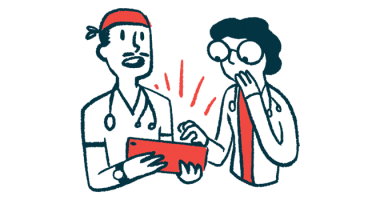Planning a wedding with porphyria was scary but oh so worth it
Rare disease can make big events intimidating, but this columnist persevered

Blaming COVID-19 was convenient the first two times Michael and I canceled our wedding. For me, it was an easier excuse than the truth.
In managing acute hepatic porphyria (AHP), the rituals of life fall away. AHP is a rare, unpredictable disease that produces chronic and acute symptoms. My body dictates my plans and doesn’t consult with me first.
Holding a wedding was risky, particularly because AHP had impacted me in novel and increasingly intense ways in recent years. I was haunted by thoughts of becoming ill on the big day. I imagined what I’d tell Michael that morning while lying in bed, and what we’d tell our family, who don’t really understand my rare disease. I was concerned that out-of-state guests would be irritated after the hassle and expense of flying to a tiny airport in the middle of the country.
We’d already canceled three dates when my 98-year-old grandma and best friend in the universe asked if the wedding was ever going to happen. “I want to be there to catch the bouquet,” she said with a smile.
Michael and I laid out worst-case scenarios and proposed solutions to hypothetical problems. I promised to take precautions in the preceding days, including obtaining a Panhematin infusion (hemin for injection) at the first sign of trouble. Plenty of people with active illnesses have weddings. So we set a date for three months later, on Saturday, Aug. 19. Regardless of what happened, we were in this together.
The emotional search for a dress
I’m not a shopper, and nothing about the wedding-planning process felt more intimidating to me than finding that “perfect” wedding dress. I found a rental site and ordered three styles to arrive on my doorstep before Memorial Day weekend.
That Saturday, we took the family to visit one of my best friends, Jennifer. If I wanted to try these dresses on, I’d need emotional support. I packed the boxes into the back of our car. When we arrived in Kansas City, I quickly unloaded them into the guest bedroom, stacking them in a shadowy corner like hidden blocks.
No one mentioned the dresses all weekend, until we returned from brunch on Monday morning. “Is it time?” Jennifer asked me, expectantly. The ominous stack of boxes was still there, right where I’d left them. I was overwhelmed, but finding a dress was merely a distraction.
The first dress I tried on had a lot of fabric. The second was cute, but scratchy. The third was a gorgeous off-the-shoulder trumpet dress with hooks and eyes up the bodice. I looked in Jennifer’s full-length mirror as she unhooked the back, and suddenly felt dizzy. I clumsily backed into my friend before we both collapsed in bed. I was sobbing and confused.
Looking back, I was mourning the carefree wedding dress shopping experience that’s been sold to me since childhood. I was angry about taking so many precautions surrounding the day. I was sad, because no matter how diligently I prepared, I still might have to sit on the sidelines. Worse yet, I might have to leave before the reception was over.
Taking back my wedding day
My AHP is not a secret, but its invisibility and complexity come with misunderstandings. Beneath my left collarbone there’s a lump attached to a short tube that snakes up and into my neck. This implanted port, plus a matching set of scars on my right side, is the clearest indication of my disease. There was a time when I would have shied away from spaghetti straps, opting instead for a high neckline. Now, I hardly notice the port.
I was going about my dress search all wrong. Nothing about our ceremony or reception was traditional. And I was trying to make things as simple as possible. So why was I looking at fancy gowns? What I really wanted was a minimal, white, fitted fairy tale of a dress to twirl when we danced the Charleston. I wanted to show off the new tattoo on my left upper arm and be able to wear standard undergarments. Once I had these new parameters in place, I found the dress of my dreams in no time: a sleeveless, A-line, midi-dress with lace overlay by Club Monaco.

Columnist Claire Richmond didn’t let AHP stop her from dancing the night away with her new spouse, Michael, at their wedding in August. (Photo by Rachel Mummey)
Looking through wedding photos now, I can see a shadow on my chest from my port, and pride stings softly behind my eyes. I chose not to let fear get in the way of our wedding, and I’m happy to report that on our big day I felt strong and stable. Our ceremony was beautiful, and the reception was more fun than we’d ever imagined.
In the days following, I experienced a new kind of physical exhaustion, one that comes from having nearly everyone you love most in the world in the same room for a night.
Note: Porphyria News is strictly a news and information website about the disease. It does not provide medical advice, diagnosis, or treatment. This content is not intended to be a substitute for professional medical advice, diagnosis, or treatment. Always seek the advice of your physician or other qualified health provider with any questions you may have regarding a medical condition. Never disregard professional medical advice or delay in seeking it because of something you have read on this website. The opinions expressed in this column are not those of Porphyria News or its parent company, BioNews, and are intended to spark discussion about issues pertaining to porphyria.








Comments